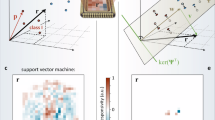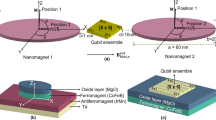Abstract
The field of nanomagnetism has recently attracted tremendous attention as it can potentially deliver low-power, high-speed and dense non-volatile memories. It is now possible to engineer the size, shape, spacing, orientation and composition of sub-100 nm magnetic structures. This has spurred the exploration of nanomagnets for unconventional computing paradigms. Here, we harness the energy-minimization nature of nanomagnetic systems to solve the quadratic optimization problems that arise in computer vision applications, which are computationally expensive. By exploiting the magnetization states of nanomagnetic disks as state representations of a vortex and single domain, we develop a magnetic Hamiltonian and implement it in a magnetic system that can identify the salient features of a given image with more than 85% true positive rate. These results show the potential of this alternative computing method to develop a magnetic coprocessor that might solve complex problems in fewer clock cycles than traditional processors.
This is a preview of subscription content, access via your institution
Access options
Subscribe to this journal
Receive 12 print issues and online access
$259.00 per year
only $21.58 per issue
Buy this article
- Purchase on Springer Link
- Instant access to full article PDF
Prices may be subject to local taxes which are calculated during checkout





Similar content being viewed by others
References
Park, J., Zha, H. & Kasturi, R. in Computer Vision—ECCV 2004 (eds Pajdla, T. & Matas, J.) 390–401 (Springer, 2004).
Maciel, J. & Costeira, J. A global solution to sparse correspondence problems. IEEE Trans. Pattern Anal. Mach. Intell. 25, 187–199 (2003).
Ng, A. Y., Jordan, M. I. & Weiss, Y. On spectral clustering: Analysis and an algorithm. Adv. Neural Inf. Proc. Syst. 2, 849–856 (2002).
Shi, J. & Malik, J. Normalized cuts and image segmentation. IEEE Trans. Pattern Anal. Mach. Intell. 22, 888–905 (2000).
Sarkar, S. & Soundararajan, P. Supervised learning of large perceptual organization: graph spectral partitioning and learning automata. IEEE Trans. Pattern Anal. Mach. Intell. 22, 504–525 (2000).
Rota Bulò, S., Pelillo, M. & Bomze, I. M. Graph-based quadratic optimization: A fast evolutionary approach. Comput. Vis. Image Und. 115, 984–995 (2011).
Levin, A., Rav Acha, A. & Lischinski, D. Spectral matting. IEEE Trans. Pattern Anal. Mach. Intell. 30, 1699–1712 (2008).
Liu, Y., Zhang, D., Lu, G. & Ma, W.-Y. A survey of content-based image retrieval with high-level semantics. Pattern Recogn. 40, 262–282 (2007).
Iqbal, Q. & Aggarwal, J. K. Retrieval by classification of images containing large manmade objects using perceptual grouping. Pattern Recogn. 35, 1463–1479 (2002).
Larsen, P., Rawlings, J. & Ferrier, N. Model-based object recognition to measure crystal size and shape distributions from in situ video images. Chem. Eng. Sci. 62, 1430–1441 (2007).
Michaelsen, E., Soergel, U. & Thoennessen, U. Perceptual grouping for automatic detection of man-made structures in high-resolution SAR data. Pattern Recog. Lett. 27, 218–225 (2006).
Parkin, S. S. et al. Giant tunnelling magnetoresistance at room temperature with MgO (100) tunnel barriers. Nature Mater. 3, 862–867 (2004).
Åkerman, J. Toward a universal memory. Science 308, 508–510 (2005).
Li, J., Ndai, P., Goel, A., Salahuddin, S. & Roy, K. Design paradigm for robust spin–torque transfer magnetic RAM (STT MRAM) from circuit/architecture perspective. IEEE Trans. Very Large Scale Integr. (VLSI) Syst. 18, 1710–1723 (2010).
Cowburn, R. P. & Welland, M. E. Room temperature magnetic quantum cellular automata. Science 287, 1466–1468 (2000).
Imre, A. et al. Majority logic gate for magnetic quantum-dot cellular automata. Science 311, 205–208 (2006).
Alam, M. et al. Experimental progress of and prospects for nanomagnet logic (NML). In Silicon Nanoelectronics Workshop (SNW) 1–2 (2010).
Karunaratne, D. K. & Bhanja, S. Study of single layer and multilayer nano-magnetic logic architectures. J. Appl. Phys. 111, 07A928 (2012).
Yilmaz, Y. & Mazumder, P. Nonvolatile nanopipelining logic using multiferroic single-domain nanomagnets. IEEE Trans. Very Large Scale Integr. (VLSI) Syst. 21, 1181–1188 (2013).
Vacca, M. et al. Magnetoelastic clock system for nanomagnet logic. IEEE Trans. Nanotechnol. 13, 963–973 (2014).
Anderson, N. G. & Bhanja, S. in Field-Coupled Nanocomputing: Paradigms, Progress, and Perspectives (eds Anderson, N. G. & Bhanja, S.) 8280 (Springer, 2014).
Behin-Aein, B., Datta, D., Salahuddin, S. & Datta, S. Proposal for an all-spin logic device with built-in memory. Nature Nanotech. 5, 266–270 (2010).
Behin-Aein, B. Computing multi-magnet based devices and methods for solution of optimization problems. US patent 8,698,517 (2014).
Behin-Aein, B., Sarkar, A. & Datta, S. Modeling circuits with spins and magnets for all-spin logic. In Proc. European Solid State Dev. Res. Conf. 36–40 (IEEE, 2012).
Csaba, G. & Porod, W. Computational study of spin–torque oscillator interactions for non-Boolean computing applications. IEEE Trans. Magn. 49, 4447–4451 (2013).
Desolneux, A., Moisan, L. & Morel, J.-M. in Seeing, Thinking and Knowing (ed. Carsetti, A.) 71–101 (Springer, 2004).
Boykov, Y., Veksler, O. & Zabih, R. Fast approximate energy minimization via graph cuts. IEEE Trans. Pattern Anal. Mach. Intell. 23, 1222–1239 (2001).
METSlib: an open source tabu search metaheuristic framework in modern C++; https://projects.coin-or.org/metslib
Kügel, A. Diplom-Informatiker Universität Ulm; http://www.maxsat.udl.cat/12/solvers/akmaxsat.pdf
IBM ILOG CPLEX Optimizer 12.6.1; http://www-01.ibm.com/software/integration/optimization/cplex-optimizer/
Sarkar, S. & Bhanja, S. Synthesizing energy minimizing quantum-dot cellular automata circuits for vision computing. In 5th IEEE Conf. Nanotechnol. 541–544 (IEEE, 2005).
Sarkar, S. & Bhanja, S. Direct quadratic minimization using magnetic field-based computing. In IEEE Int. Workshop on Design and Test of Nano Dev. Circuits Sys. 31–34 (IEEE, 2008).
Pulecio, J., Bhanja, S. & Sarkar, S. An experimental demonstration of the viability of energy minimizing computing using nano-magnets. In 11th IEEE Conf. Nanotechnol. 1038–1042 (IEEE, 2011).
Cox, T. F. & Cox, M. A. Multidimensional Scaling (CRC Press, 2010).
Kumari, A., Sarkar, S., Pulecio, J. F., Karunaratne, D. & Bhanja, S. Study of magnetization state transition in closely spaced nanomagnet two-dimensional array for computation. J. Appl. Phys. 109, 07E513 (2011).
Scheinfein, M. R. LLG micromagnetic simulator; http://llgmicro.home.mindspring.com/ (1997).
Das, J., Alam, S. M. & Bhanja, S. Non-destructive variability tolerant differential read for non-volatile logic. In IEEE 55th Int. Midwest Symp. Circuits Sys. 178–181 (IEEE, 2012).
Das, J., Alam, S. M. & Bhanja, S. Ultra-low power hybrid CMOS-magnetic logic architecture. IEEE Trans. Circuits Syst. I, Reg. Papers 59, 2008–2016 (2012).
Lambert, C.-H. et al. All-optical control of ferromagnetic thin films and nanostructures. Science 345, 1337–1340 (2014).
Liu, S. et al. Magnetic–electrical interface for nanomagnet logic. IEEE Trans. Nanotechnol. 10, 757–763 (2011).
Becherer, M., Kiermaier, J., Breitkreutz, S., Eichwald, I. & Schmitt-Landsiedel, D. Nanomagnetic logic gate and an electronic device. US patent 8,872,547 (2014).
Dong, X. et al. Circuit and microarchitecture evaluation of 3D stacking magnetic RAM (MRAM) as a universal memory replacement. In 45th ACM/IEEE Design Automation Conf. 554–559 (IEEE, 2008).
Hosaka, S. et al. Nano magnetic column arrays fabrication for patterned media in magnetic recording using EB lithography and ion milling. In IEEE Int. Conf. Electron Dev. Solid-State Circuits 140–143 (IEEE, 2009).
McGeoch, C. C. & Wang, C. Experimental evaluation of an adiabiatic quantum system for combinatorial optimization. In Proc. ACM Int. Conf. Computing Frontiers. 23 (ACM, 2013).
IBM ILOG CPLEX Optimizer performance benchmarks; http://www-01.ibm.com/software/commerce/optimization/cplex-performance/
Jog, A. et al. in Cache revive: architecting volatile STT-RAM caches for enhanced performance in CMPs. In Proc. 49th Annu. Design Automation Conf. 243–252 (ACM, 2012).
Kultursay, E., Kandemir, M., Sivasubramaniam, A. & Mutlu, O. Evaluating STT-RAM as an energy-efficient main memory alternative. In 2013 IEEE Int. Symp. Performance Analysis Sys. Software 256–267 (IEEE, 2013).
Wang, K., Alzate, J. & Amiri, P. K. Low-power non-volatile spintronic memory: STT-RAM and beyond. J. Phys. D: Appl. Phys. 46, 074003 (2013).
Acknowledgements
The authors thank the Nanotechnology Research and Education Center at the University of South Florida and the National Science Foundation. This work was supported in part by NSF CAREER grant no. 0639624, NSF (CRI) grant no. 0551621 and NSF (EMT) grant no. 0829838. The authors thank J. Pulecio and A. Kumari for their earlier research.
Author information
Authors and Affiliations
Contributions
S.B. and S.S. proposed and supervised the project. The entire team was involved in modelling and analytical framework. R.P. implemented software code for the analytical and mathematical modelling of the nanomagnetic system under S.S's guidance. R.P. ran experiments for speed comparisons and prepared responses for the reviews with S.B. and S.S. supervision. D.K. fabricated the nanomagnetic systems and performed fabrication experiments. D.K and S.B. analysed the results of fabrication experiments. S.R. performed micromagnetic simulation experiments and programmability of the grid, with S.B's guidance. D.K. and R.P. prepared the initial draft of the paper. All authors discussed the results and modified the manuscript.
Corresponding author
Ethics declarations
Competing interests
The authors declare no competing financial interests.
Supplementary information
Supplementary information
Supplementary information (PDF 11269 kb)
Rights and permissions
About this article
Cite this article
Bhanja, S., Karunaratne, D., Panchumarthy, R. et al. Non-Boolean computing with nanomagnets for computer vision applications. Nature Nanotech 11, 177–183 (2016). https://doi.org/10.1038/nnano.2015.245
Received:
Accepted:
Published:
Issue Date:
DOI: https://doi.org/10.1038/nnano.2015.245
This article is cited by
-
Finding local optima in quadratic optimization problems in RP
Soft Computing (2024)
-
Electrically programmable magnetic coupling in an Ising network exploiting solid-state ionic gating
Nature Communications (2023)
-
Graphene-based area efficient power planning architecture design methodology for nanomagnetic logic implementation
The Journal of Supercomputing (2023)
-
Ising machines as hardware solvers of combinatorial optimization problems
Nature Reviews Physics (2022)
-
Complex free-space magnetic field textures induced by three-dimensional magnetic nanostructures
Nature Nanotechnology (2022)



